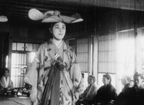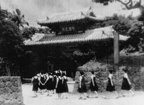Part 1
Oriental Ryukyus: Showa Era Pre-war Perspectives on Okinawa
In 1879 (Meiji 12) according to the terms of the Ryukyu Shobun (The Disposal of Ryukyu), Ryukyu was incorporated into the boundaries of Japan and became Okinawa. However, it continued to be marked by the unique binary aspect of the region in the Southern Seas—it was Japan, and yet it was not. How was the South desired and visualized by Japan’s modern? This riddle—and this problem—is already clearly expressed in the precious images that have been left to us. These carefully crafted films offer vivid depictions of Okinawa as the border of Japan.
 Okinawa
Okinawa
- 1936 / B&W / 35mm / 14 min
Photography: Kuribayashi Minoru
Editing: Kondo Iyokichi
Narrator: Egawa Ureo
Production Companies: Tokyo Nichinichi Shinbun, Osaka Mainichi Shinbun
Source: National Film Center
This short film depicts the daily life and scenery of Okinawa in the early Showa era, from around 1935 to 1945. It presents the city of Naha, Shuri Castle and other sites, along with pre-war buildings and scenery, and panoramas of city and farming landscapes. These pastoral images, however, contrast starkly with the voiceover that suggests an ever-quickening proximity to the Greater East Asia War. Going far beyond introducing Okinawa, this valuable film conveys the role assigned to Okinawans in assimilation policies and the colonial advance to the south.
 Scenes from the Main Island of Okinawa and the Surrounding Islands (Unedited film shot by Kawamura Tadao)
Scenes from the Main Island of Okinawa and the Surrounding Islands (Unedited film shot by Kawamura Tadao)
(“Okinawa honto oyobi shuhen rito no fubutsu”) 1936-40 / Silent film / B&W / Video (orig. 8mm) / 40 min
1936-40 / Silent film / B&W / Video (orig. 8mm) / 40 min
Photography: Kawamura Tadao
Source: Okinawa Prefectural Archives
This 8mm film was shot in the 1930s during fieldwork conducted by Kawamura Tadao, who researched the kinship, property systems, languages and lifestyles of various Ryukyu Islands and authored Search for the Culture of the South (1939) and Search for the Culture of the South, Continued (1943). This film captures historical sites such as Naminoue, Tamaudun, Shureimon, the main palace of Shuri Castle and Hakugindo in Itoman, as well as the lifestyle of commoners such as female divers at a fish market, Ryukyuan dancers, shamans and hajichi (a tatoo on the back of women’s hands), crowds at a bull fight and a group of people weaving a rope for a ritual tug-of-war. For Okinawa where almost everything was lost in the war, this is a very rare document that offers clues about pre-war days.
Ryukyu Arts
(“Ryukyu no mingei”)- 1939 / B&W / 16mm / 11 min
Ryukyu Scenes
(“Ryukyu no fubutsu”)-
1940 / B&W / 16mm / 13 min
Supervisors: Yanagi Soetsu, Shikiba Ryuzaburo
Photography, Editing: Ikai Suketaro
Sound: Tojo Kenjiro
Music: Yanagi Kaneko, Yamauchi Yoshiaki
Titles: Serizawa Keisuke
Planning: The Japan Folk Crafts Association
Production Company: Dainippon Bunka Eiga Seisakusho
Source: The Japan Folk Crafts Museum
Shot primarily on location in the towns of Itoman, Shuri and Tsuboya, these two pre-war films present the landscape of Okinawan daily life and introduce the arts and crafts of each locale. The films offer glimpses of uminchu (fishermen)’s expressions, traditional architecture, popular cuisine, funeral parades, the atmosphere of bustling markets, and traditional crafts such as Tsuboya-yaki pottery and Bashofu cloth. These works show that the representation of local scenery and folk art, which at first glance seem to be artless “slice of life” pieces of culture, in fact manifest the spirit of the era.
 Southern Ryukyu Islands
Southern Ryukyu Islands
(“Minami no shima: Ryukyu”)- circa 1940 / No dialogue / B&W / 16mm / 11 min
Production Company: Osaka Mainichi Shinbun Library
Source: National Film Center
This documentary introduces pre-war Okinawa. Although short, the film is a classic example of the perspective from which Okinawa was typically depicted, and readily shows the things that drew people to Okinawa. Images of the “ecology of frightening habu pit vipers” alone give a glimpse of Ryukyu that knits together the primitive and exotic.
 People of the Sea: Okinawa Island Story
People of the Sea: Okinawa Island Story
(“Umi no tami: Okinawa jima monogatari”)- 1942 / B&W / 35mm / 27 min
Director: Murata Tatsuji
Photography: Fujita Eijiro, Irisawa Ryohei
Sound: Abe Tsuneo
Production Company: Toa Hassei Eiga
Source: National Film Center
This propaganda film was made to encourage national mobilization during the war. It shows how the Greater East Asian Co-Prosperity Sphere amounted to an expansionist program of ethno-fundamentalism. But at the same time, it raises the question why Okinawa and its fishing village of Itoman served effectively as a moral exemplar of support for the wartime regime, by singling out the waves of Okinawan out-migration to the colonies, the powerful bodies and devoted minds of its people, their labor and stoicism, and the consaguineous community.
